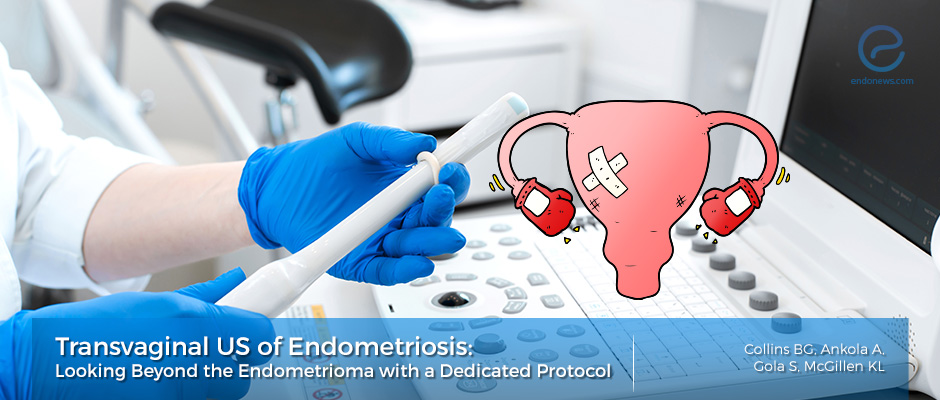Transvaginal Ultrasound of Endometriosis
Nov 4, 2019
Transvaginal ultrasound- an irreplaceable tool for the detection of Endometriosis
Key Points
Importance:
- Transvaginal ultrasound continues to be an important imaging modality for the evaluation of endometriosis for appropriate management and intervention.
Highlights:
- Transvaginal ultrasound allows for real-time and dynamic assessment of pelvic, adnexal, and deeply infiltrating endometriosis.
What’s done here:
- Collins et. al. review the evaluation of endometriosis using transvaginal ultrasound and propose a dedicated imaging protocol so that diagnostic radiologists can utilize a standardized method of assessing the full extent of endometriosis.
Key Results:
- According to the authors, there are four main components of a thorough dedicated transvaginal ultrasound exam for endometriosis:
- Evaluation of the uterus and adnexa
- Assessment of deeply infiltrating endometriosis
- Assessment of the sliding sign
- Detection of sonographic ‘soft markers’
Limitations:
- The proposed TVUS protocol requires knowledgeable and experienced ultrasound operators.
Lay Summary
A recent manuscript published by Collins et al. from the Department of Radiology at Penn State Hershey Medical Center aims to review the transvaginal ultrasound (TVUS) evaluation of endometriosis and offer a protocol that is dedicated to the thorough evaluation of women suspected to have endometriosis.
The International Deep Endometriosis Analysis (IDEA) Consensus Group, a panel of experts convened to standardize US assessment of endometriosis have recently agreed that routine pelvic US protocols are not enough to evaluate all the nuances of endometriosis. In order to increase detection rates and lessen inconsistencies in TVUS evaluation, authors proposed a protocol that includes static evaluation of the ovaries and uterus to identify possible adenomyosis, endometrioma, fallopian tube abnormalities, and deeply infiltrating endometriosis. Physical features to assess critical areas such as the pouch of Douglas and bladder involvement using the sliding sign, mobility on physical exam and US, and tenderness to palpation were also included in the protocol.
Evaluation of the Uterus and Adnexa using TVUS and physical examination should rule out tubal disease, adhesions, myometrial changes, an abnormal interface between myometrium and endometrium, linear striations or hyperechoic nodules as seen in adenomyosis, and peritoneal involvement around the uterus, which may represent deeply infiltrating endometriosis. The superficial and deep peritoneum should also be assessed as endometriosis can either invade or grow superficial to this structure.
DIE is defined as a greater than 5-mm extension of endometrial glands into the peritoneum with or without organ involvement. The evaluation of deep infiltrating endometriosis should also include location, size, presence of fibrosis using the sliding sign, organ mobility as well as extra-uterine involvement. Endometriomas may be seen as either uni- or multilocular cyst with either low-level echoes (as seen in internal hemorrhage), visible decipherable fibrous capsule without internal vascularity or solid component. However, many endometriomas are atypical and can have a fluid level or an internal avascular nodule that can project into the endometrioma. The appearance of the ovarian margins should also be performed.
Evaluation of DIE can alternatively be achieved by dividing pelvic structures into anterior and posterior compartments. Within the anterior compartment, the bladder (preferably with some urine distending the bladder), ureters, ureterovesical region, and anterior uterine serosa should be evaluated. In the posterior compartment, the uterosacral ligaments, bowel, and rectovaginal area should be assessed for involvement. Careful note of nodules either below or above the peritoneal reflection which divides the lower anterior rectum from the upper anterior rectum should be made as it has important preoperative implications. As the bladder is the most common location of urinary tract involvement in DIE, the dome, serosal and muscular layers of the bladder should be evaluated. The involvement of the ureter is often clinically silent and unfortunately can become so severe that renal obstruction and urine outflow obstruction of the kidney can lead to renal failure. Thus, assessment of the kidneys to evaluate for occult hydronephrosis should be made as well as the presence of nodules outside or inside the ureters.
Due to the complexity of endometriosis and the countless clinical presentations of this disease, the TVUS evaluation of endometriosis is both complex and is operator dependent. Thus, operators that aim to achieve a thorough evaluation of endometriosis using TVUS should be appropriately trained.
Research Source: https://www.ncbi.nlm.nih.gov/pubmed/31498746
endometriosis diagnostic radiology ultrasound transvaginal ultrasound detection
DISCLAIMER
EndoNews highlights the latest peer-reviewed scientific research and medical literature that focuses on endometriosis. We are unbiased in our summaries of recently-published endometriosis research. EndoNews does not provide medical advice or opinions on the best form of treatment. We highly stress the importance of not using EndoNews as a substitute for seeking an experienced physician.<< Previous Article

